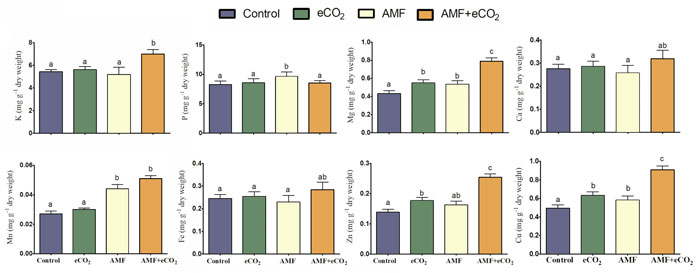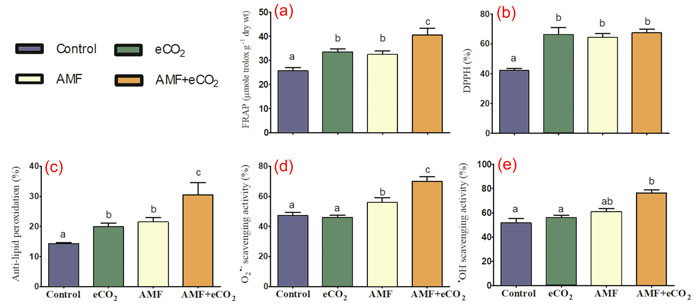| Tweet | Follow @co2science |
Paper Reviewed
Saleh, A.M., Abdel-Mawgoud, M., Hassan, A.R., Habeeb, T.H., Yehia, R.S. and AbdElgawad, H. 2020. Global metabolic changes induced by arbuscular mycorrhizal fungi in oregano plants grown under ambient and elevated levels of atmospheric CO2. Plant Physiology and Biochemistry 151: 255-263.
Saleh et al. (2020) begin their paper by discussing the virtues of utilizing both arbuscular mycorrhizal fungi (AMF) and atmospheric CO2 enrichment to improve plant growth and yield. With respect to AMF, they write "symbiotic AMF-plant association results in several beneficial effects, including improved plant growth and development, increased nutrient uptake, especially phosphorus (P) and other immobile nutrients, and enhanced levels of bioactive phytochemicals (Avio et al., 2018)," adding "AMF have [also] been reported to increase plant resistance to both biotic and abiotic stresses (Folli-Pereira et al., 2012)." With respect to CO2 enrichment, they say "elevated CO2 (eCO2) can effectively improve photosynthetic rate, enhance water use efficiency and induce global metabolic changes in many plants." Consequently, they go on to hypothesize that "the co-application of AMF and eCO2 in agricultural practices could afford an additive value over the use of either AMF or eCO2 alone." And so the six scientists thus set out to test this hypothesis on oregano, a key perennial herb of important nutritional and medicinal value.
According to the authors, oregano (Origanum vulgare) "is well-known for its culinary and medicinal uses." The content of its essential oils, flavonoids, terpenoids, phenolic acids and alkaloids, for example, are known for their antibacterial, antivirus, anti-inflammation and antioxidant pharmacological properties (Tiexeira et al., 2013; Martins et al., 2014). Consequently, Saleh et al. write "increasing the production of these classes of bioactive phytochemicals in oregano is a worthwhile goal to improve its nutritional and medicinal value."
The experimental setup of their study included growing oregano seedlings in controlled environment chambers for six weeks in a full-factorial design of ambient (410 ppm) or elevated (620 ppm) CO2 levels and a soil medium that was either inoculated or not inoculated with AMF. Specifically, the four treatments included (1) Control (ambient CO2, no AMF), (2) eCO2 (elevated CO2 and no AMF), (3) AMF (ambient CO2, soil inoculated with AMF) and (4) AMF + eCO2 (elevated CO2 and soil inoculated with AMF). The key findings are presented in the four figures below.
Starting with Figure 1, both photosynthesis and biomass were enhanced by eCO2 and AMF alone and in combination. Compared to control conditions, photosynthesis increased by 22%, 32% and 87% and biomass increased by 58%, 69% and 114% in the AMF, eCO2 and AMF + eCO2 treatments, respectively, signaling an additive effect of eCO2 and AMF in their combined treatment.

Figure 1. Biomass dry weight production (a) and rates of photosynthesis (b) in oregano grown under normal conditions (control; 410 ppm CO2) or elevated CO2 atmosphere (eCO2; 620 ppm), inoculation with arbuscular mycorrhizal fungi (AMF) or their combination (AMF + eCO2). Values are mean ± standard error of three independent replicates. Bars with same lowercase letter do not differ significantly at the 0.05 probability level as revealed by Tukey's test. Adapted from Saleh et al. (2020).
Figure 2 displays the accumulation of macronutrients and micronutrients by treatment condition. As reported by Saleh et al., "results revealed that AMF colonized O. vulgare accumulated higher levels of Mg, P Cu and Mn, as compared with non-mycorrhizal control plants." In addition, elevated CO2 alone caused "significant increments in the contents of Mg, Zn and Cu." In combination, eCO2 and AMF "caused a further increase in the levels of almost all the detected mineral elements."

Figure 2. Accumulation of macro- (top row) and micronutrients (bottom row) in oregano grown under normal conditions (control; 410 ppm CO2) or elevated CO2 atmosphere (eCO2; 620 ppm), inoculation with arbuscular mycorrhizal fungi (AMF) or their combination (AMF + eCO2). Values are mean ± standard error of three independent replicates. Bars with same lower-case letter do not differ significantly at the 0.05 probability level as revealed by Tukey's test. Adapted from Saleh et al. (2020).
Shifting focus to Figure 3, Saleh et al. found the phytochemical content (i.e., primary and secondary metabolites) was enhanced by eCO2 alone, AMF alone and by eCO2 and AMF combined. And once again, the combined treatment showed a synergistic effect, increasing total sugars, total soluble sugars, organic acids (including citric, fumaric, isobutyric, malic, oxalic and Succinic)), total essential amino acids, total non-essential amino acids, total saturated fatty acids, mono unsaturated fatty acids, poly unsaturated fatty acids and total phenolics by 36%, 39%, 69%, 77%, 80%, 48%, 98%, 85% and 81%, respectively, compared to control conditions. With respect to such enhancements, the authors say "the accumulation of such primary metabolites could improve the nutritive value of O. vulgare where sugars and organic acids are linked to taste and flavor (Malundo et al., 2001) and essential amino acids are involved in several biological processes, like protein synthesis (Al-Alawi et al., 2017)." Moreover, they continue, "a higher proportion of unsaturated fatty acids is linked to cardio-protective effects (Livingstone et al., 2012)."

Figure 3. Percent change (relative to control; 410 ppm CO2) in levels of sugars, organic acids, amino acids, fatty acids and phenolic compounds in shoot tissues of oregano grown under elevated CO2 atmosphere (eCO2; 620 ppm), inoculation with arbuscular mycorrhizal fungi (AMF) or their combination (AMF + eCO2). The percentages were calculated from data presented in the authors' Table 2.
Finally, concluding with Figure 4, Saleh et al. report significant increases in the total antioxidant capacities, radical scavenging activities and anti-lipid vigor, particularly in the combined AMF + eCO2 treatment, which hold important implications for relieving oxidative and other stresses.
In summing up these several favorable findings, the authors write eCO2 and AMF application are "reliable techniques that can be used to improve growth and the nutritive and medicinal values of oregano, however their synchronous application is much more beneficial." Such a conclusions, they add, is "supported by the improved photosynthesis, nutrients uptake, biomass production and higher accumulation of primary (sugars, amino acids, fatty acids and organic acids) and secondary (phenolic acids and flavonoids) metabolites."
With studies like this, it is easy to recognize the undeniable fact that atmospheric CO2 is not a pollutant, but an important aerial fertilizer capable of enhancing both the quantity and quality of Earth's vegetation.

Figure 4. Total antioxidant capacity (a and b), anti-lipid peroxidation (c) and free radical scavenging activities (d and e) of oregano grown under normal conditions (control; 410 ppm CO2) or elevated CO2 atmosphere (eCO2; 620 ppm), inoculation with arbuscular mycorrhizal fungi (AMF) or their combination (AMF + eCO2). Values are mean ± standard error of three independent replicates. Bars with same lower-case letter do not differ significantly at the 0.05 probability level as revealed by Tukey's test. Adapted from Saleh et al. (2020).
References
Al-Alawi, R.A., Al-Mashiqri, J.H., Al-Nadabi, J.S.M., Al-Shihi, B.I. and Baqi, Y. 2017. Date palm tree (Phoenix dactylifera L.): natural products and therapeutic options. Frontiers in Plant Science 8: 845.
Avio, L., Turrini, A., Giovannetti, M. and Sbrana, C. 2018. Designing the ideotype mycorrhizal symbionts for the production of healthy food. Frontiers in Plant Science 9: 1089.
Folli-Pereira, M. da S., Meira-Haddad, L.S., Bazzolli, D.M.S. and Kasuya, M.C.M. 2012. Arbuscular mycorrhiza and plant tolerance to stress. Revista Brasileira de Ciência do Solo 36: 1663-1679.
Livingstone, K.M., Lovegrove, J.A. and Givens, D.I. 2012. The impact of substituting SFA in dairy products with MUFA or PUFA on CVD risk: evidence from human intervention studies. Nutrition Research Reviews 25: 193-206.
Malundo, T.M.M., Shewfelt, R.L., Ware, G.O. and Baldwin, E.A. 2001. Sugars and acids influence flavor properties of mango (Mangifera indica). Journal of the American Society for Horticultural Science 126: 115-121.
Martins, N., Barros, L., Santos-Buelga, C., Henriques, M., Silva, S. and Ferreira, I.C.F.R. 2014. Decoction, infusion and hydroalcoholic extract of Origanum vulgare L.: different performances regarding bioactivity and phenolic compounds. Food Chemistry 158: 73-80.
Teixeira, B., Marques, A., Ramos, C., Serrano, C., Matos, O., Neng, N.R., Nogueira, J.M.F., Saraiva, J.A. and Nunes, M.L. 2013. Chemical composition and bioactivity of different oregano (Origanum vulgare) extracts and essential oil. Journal of the Science of Food and Agriculture 93: 2707-2714.
Posted 10 August 2020



